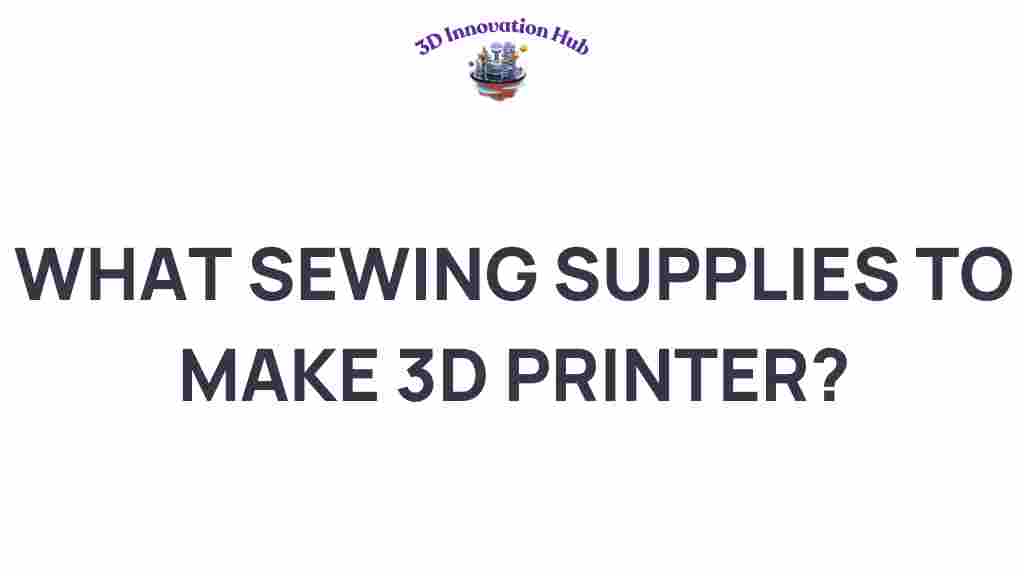Unraveling the Secrets: Essential Sewing Supplies for 3D Printing
In recent years, the world of crafting has witnessed a revolutionary shift with the advent of 3D printing technology. This innovation has not only changed how we create but has also opened up new avenues for DIY enthusiasts and professional fabricators alike. While 3D printing itself is a fascinating realm, combining it with traditional sewing supplies can lead to unique and creative projects that push the boundaries of fabrication. In this article, we will explore essential sewing supplies that can enhance your 3D printing experience, helping you achieve incredible results in your crafting endeavors.
The Intersection of Sewing and 3D Printing
3D printing is often associated with creating solid objects from digital files, but when paired with sewing supplies, the potential for innovation expands significantly. Imagine creating intricate designs that combine flexible fabrics with hard 3D-printed components. This fusion not only enhances functionality but also adds a unique aesthetic to your creations. Understanding the variety of materials available in both domains is crucial for any maker looking to innovate.
Essential Sewing Supplies for 3D Printing
To successfully merge sewing with 3D printing, you will need a range of sewing supplies that cater to different aspects of your projects. Here are some essential items that you should consider:
- Fabric: Choose fabrics that complement your 3D-printed items. Materials like cotton, spandex, or even specialty fabrics like neoprene can work well.
- Threads: Opt for high-quality threads that match your fabric choice. Polyester or nylon threads are often recommended for durability.
- Needles: Use appropriate needles based on the thickness and type of your fabric. Universal needles work well for most projects.
- Cutting Tools: Invest in rotary cutters, scissors, and cutting mats to ensure precision when cutting fabric.
- Adhesives: Fabric glue or hot glue can help secure 3D-printed parts to fabric, ensuring a strong bond.
- Snap Fasteners and Zippers: These components can enhance the functionality of your 3D-printed items, making them practical and stylish.
Choosing the Right Materials
When working on creative projects that combine 3D printing and sewing, selecting the right materials is paramount. Here are some tips to guide your material selection:
- Consider Flexibility: For parts that need to bend or flex, such as wearables, choose flexible 3D printing filaments like TPU (thermoplastic polyurethane).
- Complementary Colors: Match the colors of your fabric and threads with your 3D-printed designs for a cohesive look.
- Weight and Texture: Lighter fabrics may work better for certain designs, while thicker materials might provide the durability needed for specific applications.
Step-by-Step Process for Combining Sewing Supplies with 3D Printing
Now that you have gathered your essential sewing supplies, let’s delve into a step-by-step process for creating your next innovative project:
Step 1: Design Your Project
Begin by sketching your design. Use 3D modeling software to create the digital file for the 3D-printed components. Ensure that the parts are designed to fit seamlessly with the fabric elements.
Step 2: Print Your 3D Parts
Once your design is ready, transfer the file to your 3D printer. Choose the appropriate filament based on the properties you need (e.g., strength, flexibility). After printing, ensure that the parts are clean and ready for attachment.
Step 3: Prepare Your Fabric
Cut your fabric according to your design specifications. Use cutting tools for precision, and make sure to leave seam allowances where necessary.
Step 4: Assemble the Components
Begin attaching the 3D-printed parts to your fabric. Use fabric glue for a secure bond or sew them together for added strength. If your design requires zippers or snap fasteners, integrate these elements during this step.
Step 5: Finishing Touches
After assembling your project, check for any loose threads or unfinished edges. Use a sewing machine or hand-sew any necessary finishing stitches to complete your item.
Troubleshooting Tips
Even the most experienced crafters can encounter challenges when combining sewing and 3D printing. Here are some common issues and tips to resolve them:
- Poor Adhesion: If 3D-printed parts aren’t sticking to the fabric, try a stronger adhesive or ensure that both surfaces are clean before applying glue.
- Misalignment: If parts don’t align properly, double-check your measurements before cutting fabric and printing components.
- Fabric Damage: Be cautious when using hot glue, as it can damage some fabrics. Test a small area first if you’re unsure.
Innovative Creative Projects to Try
Now that you have the knowledge of essential sewing supplies and the process to combine them with 3D printing, let’s explore some innovative projects you can try:
- Wearable Technology: Create custom accessories or clothing that integrate 3D-printed components, such as jewelry or bags with structural elements.
- Home Decor: Design unique wall art or functional items like lamps that blend fabric with 3D-printed designs.
- Costumes: Develop intricate costumes for cosplay by merging fabric and 3D-printed elements for added flair and functionality.
Conclusion
The integration of sewing supplies with 3D printing technology presents a vast landscape of opportunities for creativity and innovation. By understanding the essential materials and techniques, DIY enthusiasts and professionals can produce stunning, functional items that showcase the best of both worlds. Whether you are crafting for fun or for commercial purposes, mastering this combination will undoubtedly elevate your projects. So gather your sewing supplies, fire up that 3D printer, and let your imagination run wild in the realm of crafting, technology, and creative projects.
For more tips on sewing and crafting, check out this helpful resource. Additionally, if you’re looking to purchase high-quality sewing supplies, consider visiting this recommended website.
This article is in the category and created by 3D Innovation Hub Team
